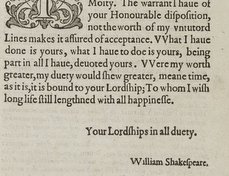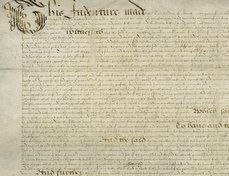Reproduced by permission of Shakespeare Birthplace Trust
Terms of use
The Shakespeare Birthplace Trust has graciously contributed images under a Creative Commons Attribution NonCommerical ShareAlike 4.0 International license. Visitors may download, link to and cite the images for personal research only. Any further use, including, but not limited to, unauthorized downloading or distribution of the images, commercial or third party use, is strictly prohibited. Visitors must contact the Shakespeare Birthplace Trust to request additional use, at: images.scla@shakespeare.org.uk
Document-specific information
Title: Stratford-upon-Avon Borough: Chamberlains' Accounts
Date: January 9, 1624
Repository: The Shakespeare Birthplace Trust, Stratford-upon-Avon, UK
Call number and opening: BRU 4/2, fols. 5-9
View online bibliographic record
Robert Bearman, "Thomas Quiney’s signature and monogram on the set of accounts which, as chamberlain, he submitted to the Stratford-upon-Avon Corporation," Shakespeare Documented, https://doi.org/10.37078/716.
Shakespeare Birthplace Trust, BRU4/2, upper board. See Shakespeare Documented, https://doi.org/10.37078/716.
Thomas Quiney, who married William Shakespeare’s daughter Judith in 1616, was elected a capital burgess on August 28, 1617 and served as constable for the years 1617/18, and 1618/19. In September 1621 he was elected chamberlain, together with Richard Robins, and both men were re-elected the following year. Normal practice was for one chamberlain to draft the main account for the first year of their joint office (but not beginning until January) and the other to check it, with roles reversed for their second year. Thus, on January 10, 1623, Richard Robins submitted his account for the year 1622, and on January 9, 1624, Thomas Quiney, as shown here, for the year 1623.
Income and expenditure during the year would presumably have been preserved in a series of notes and then written up in booklet form for submission to the Council at its January meeting. As payments in December are recorded, the accounts could only have been drawn up shortly before this January meeting. They begin (as shown here) on what would have been p. 1: “The Recepts of Thomas Quyney Chamberlane Deliuered the 09th of January 1623” (i.e. 1624, “new style”). The accounts are in a neat hand, which becomes, however, less well formed on subsequent pages. The Corporation’s income was derived largely from the property it owned and Quiney’s account therefore begins on this first page with a detailed rental of its town properties divided into six wards. The total income from property rentals was given as £55 15s. 0d. but corrected to £55 12s. 8d. as the result, apparently, of an error in the total for the final ward (Henley Street).
On the next page are further receipts, bringing the total income for that accounting year to £186 0s. 11½d. This is followed by what are called “Ordinanary payments,” that is, regular annual outgoings amounting to £91 0s. 5d. The following five pages then list “Payments exterordinary,” that is, one-off payments made during the year, bringing total outgoings for 1623 to £201 8s. 9d. The account was therefore £15 7s. 9½d. in deficit, as shown by the calculations at the foot of the final page.
On the cover, also shown here, Quiney added, probably after the event, what has been described as a signature but which more closely resembles an elaborate doodle, together with a monogram and, more interestingly, a couplet in French. His wording appears to read:
Bien hureux est celuy qui pour devenir sage
Qui pour le mal d’autry faiet son appranticage.
This is a poor rendering of the French proverb, now usually given as:
Heureux celui qui pour devenir sage
Du mal d’autrui fait son apprentissage.
This translates as: “Happy is he who, to become wise, serves his apprenticeship from other men’s troubles.” The proverb is said to derive from the writings of the French poet Mellin de Saint-Gelais (1490-1558) though whether Quiney was copying it from a printed source, or merely remembering it from days at school is unclear. Either way, these lines and his penmanship show a degree of sophistication.
Written by Robert Bearman
Last updated May 8, 2020





















